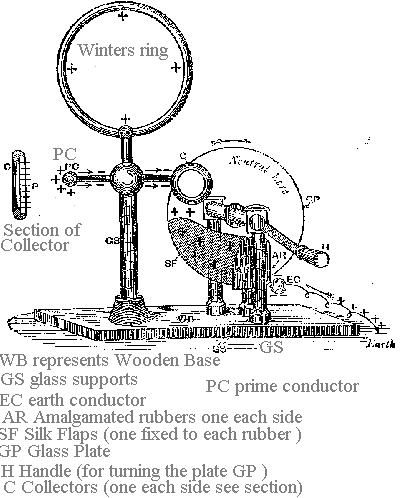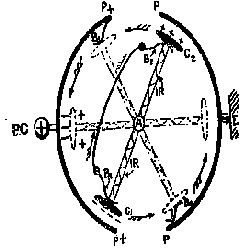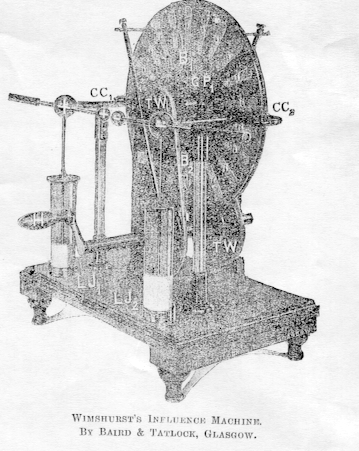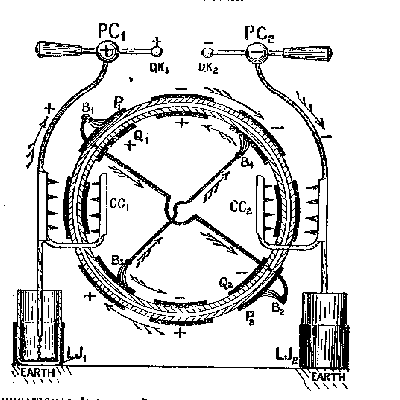
Here is an interesting article on electrostatics from the original builders fron the late 1800's and early 1900's and may be of interest to those interested in building such devices in the hunt for free energy devices. The device is constructed with amalgamated leather, technically termed the rubbers. On the back sides of these rubbbers. On the back sides of these rubbers are fixed strong bent brass springs making contact with the earth-conductor sphere, EC. This earth-conductor is connected to earth by a chain or a copper wire, fixed, if necessary, to the nearest gas or water-pipe.

The springs also serve by their elasticity to keep the rubbers pressed firmly on each side of the glass plate,
Even although the plate should be a little out of the truth. Silk flaps, SF, suspended from whalebone or ebonite rods atttached to the wooden frame of each rubber, serve to protect the glass
Earthing the prime conductor plate where it is + charged, from attracting dust or hairs, which would dissipate the charge into the atmosphere before the electricity reached the collector, C. The collector is formed of two rings of wood (one on each side of the glass plate) having pin-points, P, projecting from brass liners sunk into them, as shown by the separate sectional view of the collector.
When the rings are in position, these points face the glass plate (within half an inch of the same), and are connected to the prime conductor, PC, by horizontal brass rods screwed into the large brass ball fixed on the top of the long left-hand glass support, GS. in the upper side of this ball is bored a tapered hole to receive the shank of a metal ring covered with wood, termed Winter's ring.
Action and theory.-On turning the handle in the direction of the arrow shown on the top of GP, the friction between the amalgmated rubbers AR and the plate, generates + electricity on the glass and - on the rubbers. The (-) flows to earth or mixes with, and is neutralised by, (+) from the earth through the conducting chain or wire, thus keeping the rubbers always neutral.
The (+) being prevented from dissipation into the air by the silk flaps, SF, adheres to the glass until it comes opposite to the comb or points, P, of the collector C where it induces an equal quantity of (-) electricity of great density on the points, repelling (+) to the prime conductor and the Winter's ring.
The (-) streams off the points towards the (+) on the plate, where it neutralises or cancels all the ( +) thereon, thus leaving the plate neutral on its upper side, until it comes round to the neutral rubbers again, when the same action is repeated. The Winter's ring is simply a crude device for enlarging the surface and capacity of the prime conductor. It may be replaced by a condenser or a Leyden jar .
Earthing the Prime Conductor and Freeing the Earth-Conductor.-lf you desire to obtain - electricity from this machine,all you have to do is to remove the earthing chain or wire from EC to PC.
The (-) electrification of the rubbers charges EC negatively, whilst the (+) on the glass attracts (-) from the earth through the chain PC and the points P. If a large quantity is desired, then BC should be connected to one side of a condenser or Leyden jar, whilst the other side of the jar is put to earth.
Short Circuiting the Prime and Earth-Couductors.-lf the prime and the earth-conductor of the machine be connected together by a conductor, or "short-circuited," as it is technically termed, then there will be no free charge; for the (+ ) from the prime conductor is entirely conveyyed to the equal and opposite of the earth conductor, whereby they cancel each other, leaving the prime conductor neutral.
If both are simultaneously connected to earth, then the latter furnishes an equal quantity of to kill. the (+) generated on the prime conductor, and an equal quantity of (+) to kill the - produced on the rubbers, there by rendering the prime and earth-conductors neutral.
Freeing both prime and earth-conductors.-The rubbing of glass by the amalgamated rubbers can but produce a certain total difference of potential, which limit can only be reached when the insulation of the machine is perfect.
Tthe potential attained is generally less than the maximum possible. When the earth-conductor is connected to earth, this difference of potential is entirely +, or above the zero of the earth , but if the earth-conductor be also free and thoroughly insulated, then this total difference of potential is made up by a certain + potential above the earth on the glass plate and an equal potential below the earth on the rubbers.
When Owing to leakage this total (difference of potential has been reached, then the machine will stop generating electricity, for the prime conductor will refuse to dischard more on to the glass. There is, in fact, only a small limited - charge on the rubbers, and + on the prime conductor, owing to the low capacity of the rubber.
If we draw sparks from the prime conductor, or connect it for an instant at a time to earth, then we soon reach a condition of affairs where the whole available difference of potential is negative or below the potential of the earth and the prime conductor will give off no further sparks. If you connect by a wire one free conductor with an insulated body, and the other with another insulated body (such as the outside and inside coatings of an insulated Leyden jar or condenser ) then these bodies or coatings will also be charged to the full difference of potential which the machine can produce, whenever a sufficient number of turns his been given to the glass-plate to fill the additional capacity of the insulated bodies.
Other High-Pressure Electrical Machines.-Many other kinds of electrical machines hive been invented for producing electitification at -a high pressure. Most of these (such as the Varley, Topler,Holtz, Voss, and Wimshurst) come under the term "influence machines ; that is to say, their -action when started depends upon induction.
In the previous lecture, the principle and action of the frictional electrical machine is described.
We shall now consider another type whose principle is based on the inductive action displayed by Volta's Electrophorus of 1775.
The fundamental principle of the influence machine is the same; in fact, the influence machine is merely a convenient
mechanical arrangement for collecting and storing a number of small charges in quick succession, and thus securing a sufficiently great charge at a high pressure.
Kelvin's Replenisher.-An influence machine in its simplest form is shown by the accompanying figure, which indicates the action of the replenisher for Kelvin's original Quadrant Electrometer of 1867. This electrometer is still used for testing the loss of charge and thus the insulation resistance of dielectrics ['or submarine and other cables, ect.
If the, student thoroughly masters the principle of this device, he will have no difficulty in understanding more complex types of influence machines.

A for Axis. B,12,3,4 for. Brushes.
I R Insulating Rod. p + p - ,Metal Plates.
CIC2 Metal Carrier. + and -, or E for terminal,;.
PC for Prime Conductor.
The Influence Machine from 1788 to 1888," read by Plrofessor Silvanus P. Thompson, before the Instituiion of Electrical Engineers. See vol. xvil., No. 74, P. 569, of the proceedings
(1) Suppose a (+) charge to be given to the left-handed plates, P by a silk rubbed glass rod. When the metal carrier Cl comes under the influence of this (+) charge, a ( -) charge is then bound on its outer face, And a(+) electricity is repelled to its back face as in the horizontal position opposite to the + prime conductor PC. As C1 is turned further round it touches B1 which permits the repelled (+) to pass along the conductor to B2, and C2.
(2) When Cl touches c2, it gives up the whole of its (-) charge to the earth E1 through the right-hand plate P, and passes on neutral. At the same time, C2 passes on to B2, and gives up all it can of its ( +) charge to P +.
(3) When C1, comes to the position C2 it receives (as previously stated in case (1)a(+) charge which it also gives up to the left-hand plate on making contact with B2. This adds a further increment to the original (+) charge on the plate P+.
We see, that during each revolution of the carriers the insulated plate P+ thus receives two small charges from the carriers C1 C2
(4) If the earth connection be removed from the right-hand plate, and each plate be joined with, say, a Leyden Jar, then both plates will mutually act upon the carriers. A reverse action will take place on C2 simultaneously with that on Cl.
Conclusion.-Hence, this and all other influence machines depend upon two actions. (i.) The action of induction, which shows that a body (within the influence of an electrified body), when relieved of its free or repelled charge (by being touched or earthed), acquires a charge of electricity of the opposite kind to the inducing charge. And (ii) the more complex action of induction, depending on (i.) and known as " reciprocal accumulation," whereby successive small charges are produced, collected and stored until the pressure of the desired charge reaches the required potential; or until disruption takes place by a snapping spark between the knobs of the prime conductors.
This machine in its simplest form consists of two varnished thin highly insulating glass discs of such a diameter as will suit the purposes for which the apparattus is required
The circular plates G P have holes bored through their centre in order that they may be fixed.

To dependent axles and are so placed alongside each other that only a a narrow gap of air intervenes. They are thus capable of being rotated in opposite directions about the same horizontal axis by means of a handle H and two pairs of two of turning wheels TW with their driving cords. Strips Of tin Or other metal-foil of sector shape are cemented to, and placed at equal distances around the outer face of each of the two glass plates GP,
Details.-There are two conductors. one for each set of sectors
These conductors cross at right angles outside the faces of the glass discs. At both ends of each conductor there are fine wire flexible brushes B, which come in contact with the sectors as the glass places rotate For better contact this is usually a projecting knob or button, fixed to that part of each sector which passes beneath the brushes as in first figure.At each end of the horizontal diameter there is a collecting comb CC fixed to a vertical insulating stand. Both of these combs are bent around the outsides of the plates in horse-shoe fashion. The teeth or prongs of the combs are thus made to face the sectors, but are not permitted to touch them.
The apparatus is generally provided with two Leyden Jars, LJ connected with the Prime conductors of the machine to increase its capacity for holding a charge, whilst two adjustable discharging knobs are supported by the prime conductors and are actuated by insulated handles, for the purpose of showing brush or spark discharges. When the discharging knobs are kept at certain distances apart, and are connected to a condenser and voltmeter, the condenser may be charged to a known potential which will be indicated by the voltmeter.
Action of the Wimshurst Machine.-From an inspection of the outside perspective view, and by carefully studying the educational diagram (due to Professor S.P.Thompson), the action of this apparatus will be made clear to the student by simply applying the knowledge which he has already gained from and from the previous case of Lord Kelvin's Replenisher.

DK 1 2 for discharing knobs P1P2 for Sectors on outer or front
PC 1 2 Prime conductors. plates. LJ 1 2 Leyden jtrs. B3.,B4 Brushes and conductor
CC 1 2 Collecting combs. connecting- B1,B2. Brushes and conductor QI Q2 Sectors on inner or back
connecting plates
H and TW for Handle and Turning Wheels in the outside View.
(1) Commence by considering that the top outside metal sector plate P, has an initial negative (-) charge imparted to it, either derived from an ebonite rod rubbed with flannel or from the air, or from having been previously worked.
Let this sector be followed round towards the right hand as it turns in a
clockwise direction, indicated by the outside arrow above it. When P1 has moved
through 45 deg it faces an inner metal sector Q, and attracts and binds by
induction to the outer face of Q, a (+ charge while at the same time, it repels a
(-) charge to back of Q. This causes a(+) current to come through the brush B2
from Q2 along the cross diameter conductor to brush B, to cancel the negative charge on back of Q. This action permits the upper inner sector Q1 to pass on to the left with a(+) charge, and the lower sector Q2 to pass to the right with a (-) charge.
(2) Let the uppper and outer sector P, move through 45' more to the right -i.e., Until it comes to a horizontal position opposite the collecting combs CC,; while at the same time the 1ower. and upper
sector. Q2 has also moved through 45' into a horizontal position facing the set of collecting combs. Now, as P, and Q, come towards this position they have each a (-) charge, which naturally, by induction, draws a (+) wind or discharge from the Leyden jar LJ,
and the prime conductor PC thus leaving LJ, and PC., negatively (-) electrified, whilst the outer and inner sectors both pass on neutral
(3) As the outer plate moves 45' from the horizontal into the position P, it comes under the inductive influence of the (-) inner plate Q2
This attracts to P2, a (+) charge from Pl,' through B1 the cross conductor and B2, which permits P2 to move on with a (+) charge and Q2 with a (-) charge.,
Below is a description of an interesting electrostatic device (4)As P2 rises round from below(+), and (Q,) turns down from above also (+), until they both face the collecting combs CC1 the Leyden jar LJ, and prime conductor PC, are robbed of (-) by the(-) wind
discharge from the points of the comb-teeth upon both outer and inner sectors, thus leaving them to proceed neutral and at the same time, leave the prime contluctor PC, and the Leyden jar LJ, charged with positive (+) electrical .
(5) In this simple manner, a gradually accumulating (+) charge is imparted to the prime conductor PC, and its Leyden jar LJ whilst at the same time, a corresponding( - ) charge is given to PC and LJ
as the glass plates are rotated. If, the discharge knobs DK1 and DK2 are apart such a distance that the maximum potential between them can break down the intervening air and -a spark take place between them, the Leyden jars and prime conductor will be so far emptied and their voltage reduced that a certain number of turns of the plates must take place before another spark or discharge can occur.
Advantage. of the Wimshurst Machine.-These consist in-
(a) Simplicity and clieapness of construction.
(b) Reliability under the most adverse circumstances of
damp weather,&c., since they will start accumulating charges immediately the plates begin to revolve if they have been well made of the best materials.
(c) Non-liability to reverse their polarity as other influence
machines of the Holtz and Voss types some times do.
(d) They may be made of any desired size and number of plates from the tiny 2-inch disk up to the large 7 feet diameter two plate machines at the Science and Art Department, South Kensington. Or, they may be made of many pairs of plates like that belonging to Lord Renfrewshire which requires an engine of several horsepower to drive it, and produces lightning-like sparks of millions of volts capable of penetrating and breaking down refractory substances and thus testing their Insulating qualities.
